

Www.lampsacus.com/documents/StragegicForesight.pdf. Understanding a PESTLE Analysis and Its Components. BUSINESS and INNOVATION PROJECT PORTFOLIO ANALYSIS, Innovation Strategies. Strategy Formulation, Business Units, Strategic Analysis. What is Business Portfolio Analysis?
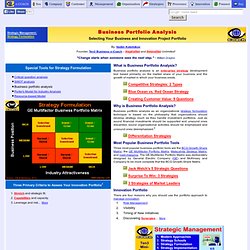
Business portfolio analysis is an enterprise strategy development tool based primarily on the market share of your business and the growth of market in which your business exists. Competitive Strategies: 2 Types Blue Ocean vs. Pest Analysis. BUSINESS PORTFOLIO ANALYSIS - Selecting Your Business and Innovation Project Portfolio. What Are the Limitations of a Pest Analysis? Written by: Sidharth Thakur • edited by: Ginny Edwards • updated: 12/26/2010 If you’re planning to use PEST analysis during strategy planning – it’s important that you understand the limitations of a Pest Analysis before relying completely on its results.
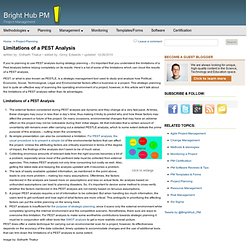
Here’s a list of some of the limitations which can cloud the results of a PEST analysis. PEST Analysis. PESTLE and SWOT. These are tools used to find out the current status and position of an organisation or individual in relation to their external environment and current role.

They can then be used as a basis for future planning and strategic management. The PESTLE analysis should be used to provide a context for the organisation’s/individual’s role in relation to the external environment. It covers Political, Economic, Social, Technological, Legal and Environmental factors. Depending on which elements are included it can also be referred to as STEP, STEEP, PESTEL, PESTLE or LEPEST.
Recently it was even further extended to STEEPLE and STEEPLED, including education and demographics. The process underpins many other analytical techniques, such as Scenario Planning. Which of the below are of most importance now? Political What are the key political drivers of relevance? Free PESTLE Analysis Example With Downloadable Template. What Is a PESTLE Analysis?

Most of us have heard of the SWOT analysis (Strengths, Weaknesses, Opportunities, and Threats) that is helpful in determining if a business or product will be viable. A PESTLE analysis pretty much does the same thing, however, considers other factors. The acronym PESTLE represents the following areas: political, economic, sociological, technological, legal, and environmental factors. Some variations of the PESTLE analysis are PEST, (without the legal or environmental factors), and a PESTLIED analysis, where international and demographic factors are considered. Rapid BI, recommends that each PESTLE analysis can be as “simple or complex” as you want it to be depending upon the project at hand. Image Credit: (Google Images) Product portfolio - the Boston Matrix (or Boston Box)
Author: Jim Riley Last updated: Sunday 23 September, 2012 Introduction to the Boston Matrix A business with a range of products has a portfolio of products.

Strategic Audit. Author: Jim Riley Last updated: Sunday 23 September, 2012 In our introduction to business strategy, we emphasised the role of the "business environment" in shaping strategic thinking and decision-making.

The external environment in which a business operates can create opportunities which a business can exploit, as well as threats which could damage a business. However, to be in a position to exploit opportunities or respond to threats, a business needs to have the right resources and capabilities in place. An important part of business strategy is concerned with ensuring that these resources and competencies are understood and evaluated - a process that is often known as a "Strategic Audit". The process of conducting a strategic audit can be summarised into the following stages: What is strategy? Author: Jim Riley Last updated: Sunday 23 September, 2012 Overall Definition: Johnson and Scholes (Exploring Corporate Strategy) define strategy as follows: "Strategy is the direction and scope of an organisation over the long-term: which achieves advantage for the organisation through its configuration of resources within a challenging environment, to meet the needs of markets and to fulfil stakeholder expectations".
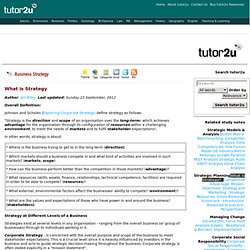
In other words, strategy is about: Strategy at Different Levels of a Business Strategies exist at several levels in any organisation - ranging from the overall business (or group of businesses) through to individuals working in it. Corporate Strategy - is concerned with the overall purpose and scope of the business to meet stakeholder expectations. SWOT analysis - introduction. Author: Jim Riley Last updated: Sunday 23 September, 2012 SWOT analysis is a method for analysing a business, its resources, and its environment.
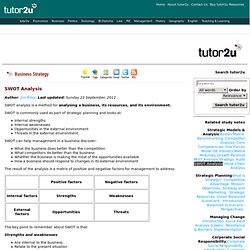
SWOT is commonly used as part of strategic planning and looks at: Internal strengths Internal weaknesses Opportunities in the external environment Threats in the external environment. PEST analysis. Author: Jim Riley Last updated: Sunday 23 September, 2012 PEST analysis is concerned with the key external environmental influences on a business.
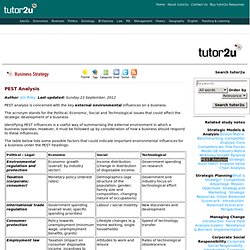
The acronym stands for the Political, Economic, Social and Technological issues that could affect the strategic development of a business. Identifying PEST influences is a useful way of summarising the external environment in which a business operates. However, it must be followed up by consideration of how a business should respond to these influences. The table below lists some possible factors that could indicate important environmental influences for a business under the PEST headings: Other Business Study Resources You Might Like on tutor2u Add your comments and share this study note: PEST Analysis - Problem-Solving Training from MindTools. Identifying "Big Picture" Opportunities and Threats (Also Known as PESTLE, PESTEL, PESTLIED, STEEPLE, SLEPT and LONGPESTLE) Learn how to use PEST Analysis to identify the threats and opportunities in your business environment.
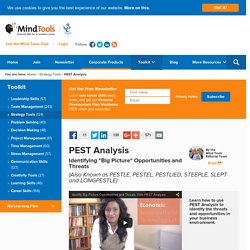
Changes in your business environment can create great opportunities for your organization – and cause significant threats. For example, opportunities can come from new technologies that help you reach new customers, from new funding streams that allow you to invest in better equipment, and from changed government policies that open up new markets. Threats can include deregulation that exposes you to intensified competition; a shrinking market; or increases to interest rates, which can cause problems if your company is burdened by debt. Understanding Portfolio Analysis. Corporate Parenting. Slideshare. Business Examples.
Virgin.